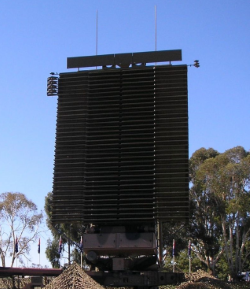Across the globe tens of GWs of wind turbine development have been hindered by stringent radar safeguarding criteria. Especially long range Air Defence Radar are often the source of sustained objections from Military Authorities.

A technical mitigation option that has resulted in the removal of Air Defence Radar objections is the use of Lockheed Martin TPS-77 Radar (pictured).
Air Defence Radar & Wind Turbines
Wind turbines can affect the performance of Air Defence Radar. The two main concerns are:
1. Overhead obscuration (also known as desensitisation) whereby due to the large wind turbine RCS compared to most target aircraft, combined with the radar’s data processing mechanism Air Defence radar lose sensitivity to such an extent that they cannot resolve small aircraft targets at any level above a wind farm.
2. Clutter (also known as false returns) whereby due to the nature of the turbines’ operation they can appear on a radar screen.
Read this article for more information on Air Defence Radar and Wind Turbines.
The TPS-77 Air Defence (AD) Radar
The TPS-77 is a long range solid-state radar developed by the US company Lockheed Martin and is currently used in many countries around the world. These include the UK, USA, Australia, Canada, Denmark, Germany and others.
It typically operates in the D/L-band (1-2 GHz frequency) and due to its long range detection capabilities it can be safeguarded to its effective range (470km/250nm).
From a technical point of view it is a 3D radar meaning that it allows the directional information to include target elevation angle with bearing. With these data the radar can calculate the true horizontal range to the target from the slant range reducing the likelihood of error.
In 2008 the UK Ministry of Defence (MOD) conducted the Draconian Gate, a flight trial in Denmark. The trial assessed the effects of the Horns Rev wind farm (one of the world’s largest offshore wind farms, located at Horns Rev in Denmark), to a Lockheed Martin TPS-77 radar. More specifically, it assessed the Probability of Detection (PD) and radar displayed results. Trial results suggested that:
- The TPS-77 achieved a high PD against all targets even in very close proximity to the wind farm.
- Outside a box of1500 feet amsl over and out to 500m from the edges of the wind farm there was no discernible impact on PD as at all times PD>95% for all trialled profiles.
TPS-77 & Wind Turbines Interference
Over the last few years the term “TPS-77” has become a well-known one among wind developers. It was often thought of as the “holy grail” with regard to wind turbines and Air Defence Radar objections. However, its good performance against wind turbine interference has not been by itself adequate (yet) to remove objections to the vast majority of single and multiple turbine developments.
The video below, by Lockheed Martin, talks about the TPS-77 as a wind farm solution:
Currently a proven way forward with military authorities in the UK is the use of Non-Auto Initiation Zones (NAIZs). A NAIZ is a defined zone in 2 or 3 dimensions within which plot extracted tracks are prevented from initiating, whist mature tracks are maintained and updated. It is established over the location of a wind turbine development and ensures that turbine blades do not create false tracks, but established aircraft tracks entering the location continue to be updated.
The number of NAIZs that can operate simultaneously is normally limited for any given radar. The size of a NAIZ depends on the width of the radar beam, radar pulse width, wind turbine dimensions, wind farm footprint, resolution at which the NAIZ can be defined and a number of other factors.
The process to obtain NAIZ mitigation is not always straightforward and usually requires an input from both the radar manufacturer/consultant and the military authority (i.e. UK MOD).
What to do when you have an Air Defence Radar objection?
Check that your turbine is likely to be detected by the radar.
A first step is to check whether the turbine will be within radar line of sight and by how much. Sometimes even when a turbine is marginally below radar line of sight, due to the diffraction effect of radio waves, detection may still be possible.
A further step is to investigate whether there are any permanent structures such as buildings that can shield the turbine.
Depending on the results of the above initial analysis more detailed analysis may need to be undertaken (i.e. radar detectability).
If technical and operational radar impact analysis shows that the assessed turbines will affect the radar then a NAIZ solution could be investigated.
Image accreditation: “RAAF radar” uploaded by Nick-D / CCBYSA / cropped and resized from original. Source: Wikipedia
